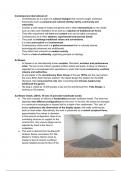Contemporary International art
- Contemporary art is a part of a cultural dialogue that concerns larger contextual
frameworks such as personal and cultural identity, family, community and
nationality.
- Includes a wide range of media and genres and is often characterised by new media
such as video and installation art as well as a rejection of traditional art forms.
- They often experiment with form and content and can be highly conceptual.
- Contemporary art is often abstract, experimental and process based.
- They seek to challenge traditional values and conventions.
- It is often provocative and controversial.
- Contemporary artists work in a global environment that is culturally diverse,
technologically advanced and multifaceted.
- They reflect and comment on modern society.
- There is a lack of uniformity, organising principle or ideology.
Ai Weiwei:
- Ai Weiwei is an internationally known sculptor, filmmaker, architect and performance
artist. The son of one China’s greatest modern artists and poets, Ai Qing, Ai Weiwei is
regarded as a conceptualist who specialises in works that create controversy, confront
viewers and authorities.
- Ai was leader in the revolutionary Stars Group of the late 1970s and the man behind
the iconic Bird's Nest Olympic stadium. He helped design the stadium for the 2008
Olympics, then renounced his role after concluding that Chinese leaders had
politicised the games.
- His blog is visited by 10,000 people a day and his architectural firm, Fake Design, is
working on 50 projects.
Sunflower Seeds, (2010), 10 tons of porcelain handmade seeds:
● This work consists of millions of handcrafted porcelain sunflower seeds. The artist has
stipulated two different configurations for the work. In the first, the seeds are arranged
in a continuous rectangular or square field to a depth of ten centimetres. This ‘bed’ of
seeds conforms to the dimensions of the display space, with walls confining the
work on three sides. Alternatively, the work is presented as a conical sculptural form,
approximately five metres in diameter.
In this second configuration, there is no
containing structure or support for the
conical form. Any uneven edges can be
adjusted by hand at the time of
installation.
● This work is derived from the Eleventh
Unilever Series commission for Tate
Modern’s Turbine Hall for which Ai
created a bed of ceramic sunflower
seeds installed across the floor of the
, space. The Unilever Series commission was the first time Ai Weiwei presented this
multitude of sunflower seeds as a continuous rectangular field to create a ‘unique
surface’, and the first time he proposed an interactive element, in which the public was
invited to walk on the seeds.
● The fabrication of the seeds was carried out in the city of Jingdezhen in northern
Jiangxi, a region of China south of Beijing. Historically famous for its kilns and for the
production of imperial porcelain, this region is still known for its high quality porcelain
production. The sunflower seeds were made by individual craftspeople in a
‘cottage-industry’ setting, rather than in a large-scale factory, using a special kind of
stone from a particular mountain in Jingdezhen.
● The symbol of the sunflower was ubiquitous during the Cultural Revolution in China
in the 1960s and 1970s, and was often used as a visual metaphor for the country’s
Communist leader Chairman Mao (1893–1976) and the whole population.
● In Sunflower Seeds Ai examines the complex exchanges between the one and the
many, the individual and the masses, self and
society. Far from being industrially produced,
the sunflower seeds are intricately and
individually handcrafted, prompting a closer
look at the ‘Made in China’ phenomenon
commonly associated with cheap
mass-produced goods. The myriad
sunflower seeds - each unique yet
apparently the same - can be seen to evoke
the quest for individuality in a rapidly
transforming society.
● Ai’s practice is increasingly driven by issues
facing contemporary China, such as the
exercise of autocratic power, the
disappearance of Chinese cultural and
material history, and concerns about human
rights, hard labour and poverty. Sunflower Seeds explores the complexity of the
Chinese individual’s relationship with society, the authorities and tradition.
Remembering, 2009, backpacks on the facade of the Haus der Kunst:
● Remembering is an art piece he created to honour over 80,000 Chinese people, most
of whom were school children who perished in the May 2008 Sichuan earthquake. It
was so captivating and popular that it rubbed the Chinese ruling regime the wrong way,
and Ai Weiwei’s career has never been the same.
● It was a simple yet moving installation on the
façade of the museum. He used 9000 school
backpacks to spell out the words “She lived
happily for seven years in this world” in
Mandarin.




